Key Points
Water snakes are part of the ecosystem in Wisconsin, especially the lakes in the state.
- Wisconsin is home to dozens of snake species, six of which are water snakes that live in or frequent lakes.
- You’ll find the most snakes at Devil’s Lake State Park and Lake Pepin.
- The most common water snakes you’ll find in Wisconsin lakes include the common water snake and the common garter snake.
Swimming in lakes is an age-old summer tradition — from Maine to California, “summers at the lake” describe a season of rest, relaxation, and fun in the sun. In Wisconsin, a state with two coastlines on the Great Lakes of Michigan and Superior, time at the lake is a family-friendly activity many enjoy.
An unwelcome guest to some festivities, snakes usually don’t factor into summer lake plans. However, many snakes live in the water, so it’s humans invading their homes — not the other way around. In Wisconsin alone, there are six species of water snakes that you may see on your next trip to a popular lake in the Badger State.
Discover the most snake-infested lakes in Wisconsin, as well as more information about water snakes and other animals you can find near lakes in Wisconsin.
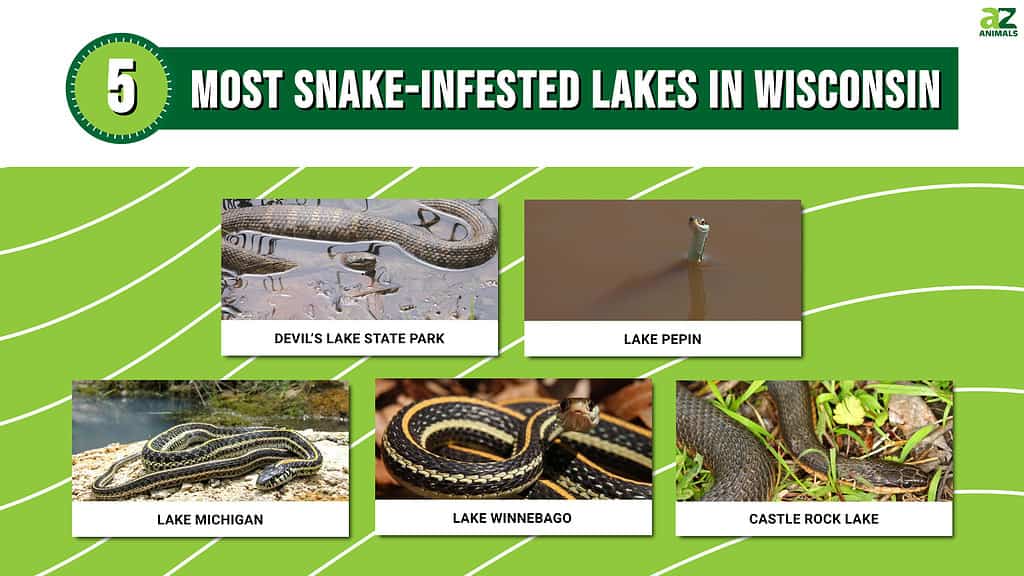
5 Most Snake-Infested Lakes in Wisconsin
Be prepared on your next trip to the lake with information and a first aid kit in case you see a snake. If you’re heading to any of these lakes, the chance of encountering one of Wisconsin’s six water snakes is pretty high.
Devil’s Lake State Park
Located around the Baraboo Range in Sauk County, Wisconsin, Devil’s Lake State Park ranks as the most popular state park with nearly three million visitors a year. Besides the lake, the park’s attractions include hiking, camping, hunting, boating, and more. The lake itself offers two beaches, one on the north and one on the south side.
What snakes can you find in Devil’s Lake State Park? There are 13 species of snakes around Devil’s Lake State Park that include the Northern water snake, the small red-bellied snake, the black rat snake, and the venomous timber rattlesnake.
Lake Pepin
Sitting on the border between Minnesota and Wisconsin, Lake Pepin is a naturally-formed lake on the Mississippi River. At 22 miles long, it stretches through several towns and offers a plethora of water activities like boating, fishing, swimming, and more. Lake Pepin also has a local legend about a serpent-like creature dubbed “Pepie” similar to the Loch Ness Monster.
What snakes can you find in Lake Pepin? Lake Pepin is home to a variety of water snakes. Expect to see the common garter snake, as well as the common water snake, when relaxing at Lake Pepin. In addition, the timber rattlesnake, Dekay’s brown snake, the ring-necked snake, and the eastern milksnake make their homes around Lake Pepin.
Lake Michigan
Wisconsin borders the Great Lake, Lake Michigan — which is home to a vast array of water snakes. On the shores of Lake Michigan in Wisconsin, however, you probably won’t bump into the most dangerous of the Lake Michigan snakes: the eastern massasauga. With hundreds of miles of coastline jutting up against Lake Michigan, the odds of seeing a snake while sunbathing, paddleboarding, playing beach volleyball, and hiking remain pretty high.
What snakes can you find in Lake Michigan? In the water and on the banks of Lake Michigan, Wisconsinites and tourists can expect to see a variety of water snakes, including the plains garter snake and the common (or northern) water snake.
Lake Winnebago
Lake Winnebago ranks as the largest lake entirely in the state at nearly 140,000 acres of land and water. Due to its location, the winter tends to bring ice shoves into Lake Winnebago. During the summer, tourists and locals can enjoy exquisite fishing on the lake.
What snakes can you find in Lake Winnebago? Most often you’ll find the common garter snake and the eastern garter snake. These snakes tend to shy away from humans but can and will bite. While a bite is not dangerous to humans or pets, it may cause itching and burning at the bite site. Monitor the bite to ensure that it doesn’t get infected.
Castle Rock Lake
Though it’s a man-made lake in Wisconsin, Castle Rock Lake is a local favorite swimming destination and home to several Wisconsin water snakes. Not only does the lake offer fishing for muskellunge, the official state fish of Wisconsin, but its large body of water is perfect for boating and other water recreational activities.
What snakes can you find in Castle Rock Lake? The common garter snake is sure to make an appearance during your trip to Castle Rock Lake. You may see the common water snake too.
Water Snakes Found in Wisconsin
Like most states in America, Wisconsin is home to a variety of snakes. Of the 21 species of snakes found in Wisconsin, only six are water snakes.
Common Water Snake (Nerodia sipedon)
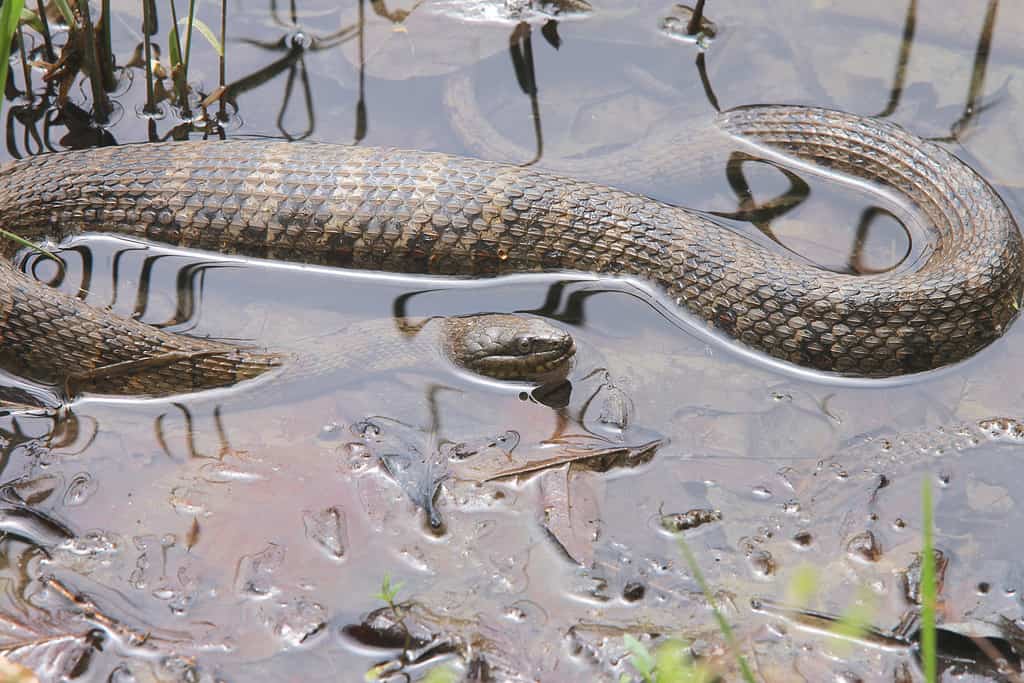
A northern water snake (
Nerodia sipedon) will usually lay in shallow water at the edge of a lake or bask on a rock.
©iStock.com/NajaShots
The common water snake is nonvenomous, though many who see them slither mistake it for a venomous cottonmouth snake. The markings between the two snakes are similar, with brown, gray, red, or brownish markings on its back. Most common water snakes grow to be an average of two to three feet, though they’ve been known to grow up to four feet long.
Common water snakes spend most of their days basking in the sun on a hot rock. At a nearby disturbance, however, the snake will immediately dive under the water and flee from danger. Common water snakes aren’t cowards, though — they will fight to defend themselves if cornered. Even without venom, their bites are painful.
Since the mid-1990s, conservation efforts have been underway to save the then-endangered common water snake. Now off the list, this water snake has a vast family that spans across the northern parts of the United States and into Canada.
Eastern Ribbon Snake (Thamnophis saurita)
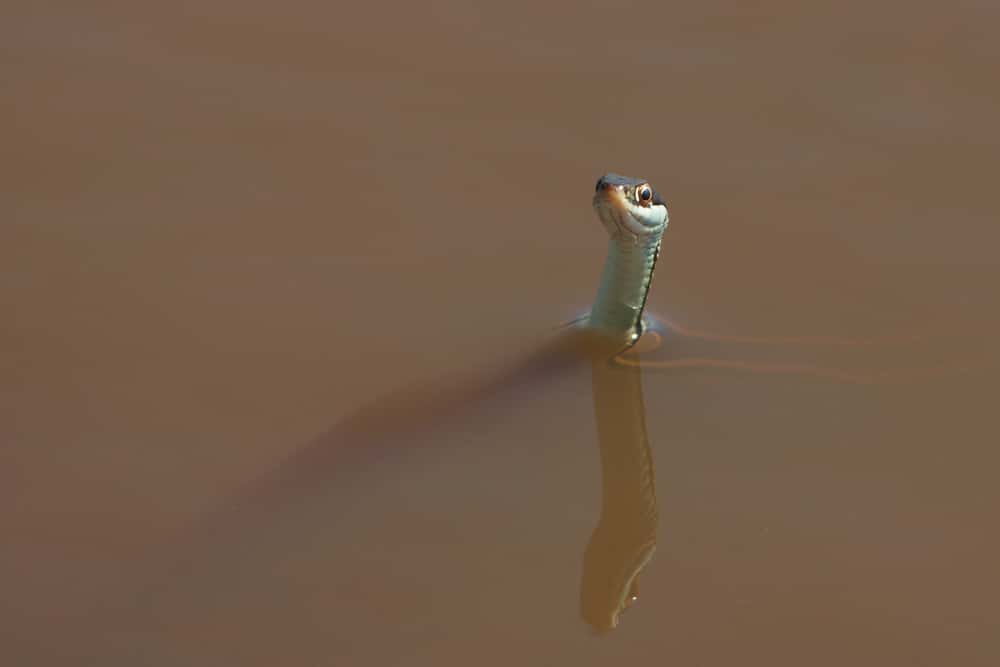
Eastern ribbon snakes slide on the top of the water to flee predators.
©Scott Payne/Shutterstock.com
Much smaller than the common water snake is the eastern ribbon snake, a subspecies only growing to 34 inches at its largest. Most eastern ribbon snakes make their homes on riverbanks and shorelines of lakes, ponds, and streams. Because they’re adapted to both environments, eastern ribbon snakes live both in and out of the water, seeking refuge in bushes or across the waves when they feel imminent danger.
Unlike water snakes, eastern ribbon snakes don’t dive under the water when frightened. Their small size enables them to glide upon the surface of the water and slide along it. In the winter months, these snakes must find shelter to hibernate; often using other creatures’ burrows like muskrat lodges and ant mounds to stay warm.
The eastern ribbon snake does not tend to bite, even when handled by humans. Instead, it excretes a foul odor from its anal glands when it feels threatened.
Plains Garter Snake (Thamnophis radix)
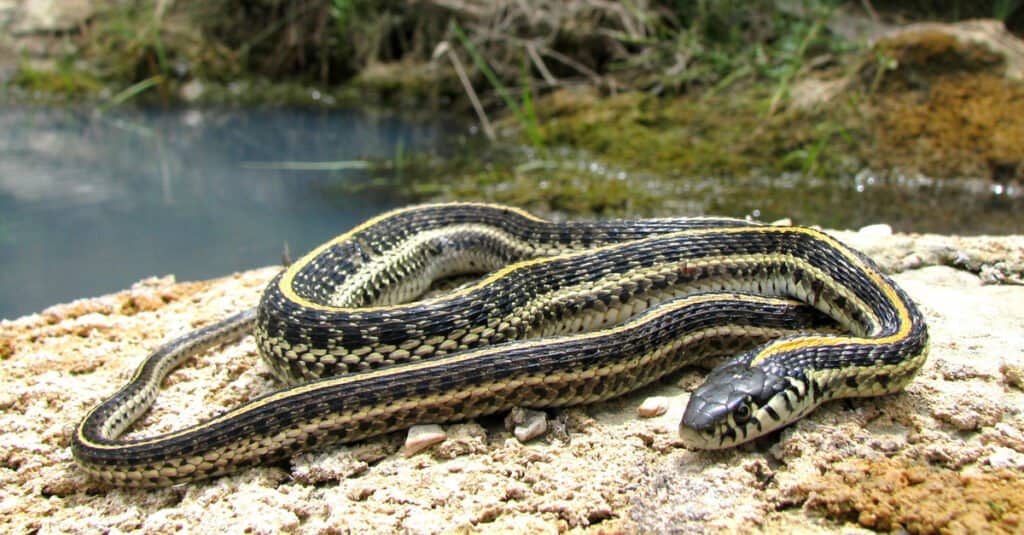
Plains garter snakes are medium-sized and mildly venomous.
©Joe Farah/Shutterstock.com
Plains garter snakes are mildly venomous to humans and pets, but their bites don’t often concern medical professionals if treated right away. The plains garter snake is native to most of the central United States and has a distinctive orange or yellow stripe down its back against an otherwise dark background. On average, the plains garter snake grows to around three feet in length.
Fans of water and hibernation, the plains garter snake has one of the most tolerant bodies to cold temperatures — it even comes out of hibernation on warmer winter days to bask in the sun.
Overall, these snakes make their homes near water. Swamps, marshes, streams, and ponds remain ideal environments for the plains garter snake. Interestingly, some experts believe the plains garter snake and the common water snake may hybridize (or crossbred) because they share their habitats closely. In Wisconsin, the conservation of the snake is of special concern, though the species is globally thought of as not being endangered.
Western Ribbon Snake (Thamnophis proximus)
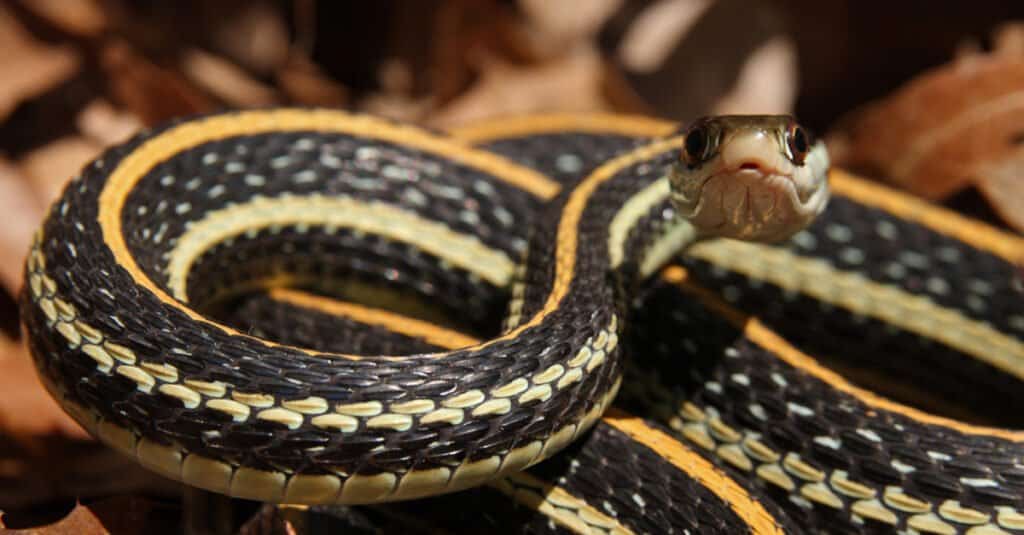
Like their cousins, western ribbon snakes also glide over the surface of the water to flee predators.
©Ryan M. Bolton/Shutterstock.com
Western ribbon snakes seek out water whenever their habitat may be, resulting in a diet of mostly tadpoles, fish, lizards, frogs, and other amphibians. They’re a nonvenomous snake based on current research and study, but some individual reports have cited the western ribbon snake’s saliva as having toxic properties. Still, herpetologists maintain that western ribbon snakes are not harmful to humans.
Western ribbon snakes grow a bit longer than their eastern counterparts at an average of 20 to 30 inches long. These aquatic snakes tend to make their habitats close to water via ponds, lakes, springs, marshes, and rivers. Quick and small, western ribbon snakes choose to take to the water rather than land when frightened. Like their eastern cousins, the western ribbon snake slides upon the surface of the water to get from one place to another. As diurnal snakes, they will actively hunt and bask throughout the day.
Queen Snake (Regina septemvittata)

Queen snakes choose to live near water sources and in trees.
©Jason Patrick Ross/Shutterstock.com
Nonvenomous and semiaquatic, queen snakes have a similar appearance to a garter snake and a discerning diet of crayfish.
Unlike other water snakes in Wisconsin, queen snakes choose very specific habitats for themselves and their brood. You will never find a queen snake outside of an environment without clean running water or watersheds with a rocky bottom. The specificity in this environment comes from the queen snake’s crayfish diet: they only nest and live close to where they can hunt. Furthermore, queen snakes use their tongues to taste where the newly-mottled crayfish hatch, which is why clean water remains so important to their lifestyle.
As docile snakes, it’s unlikely for a queen snake to bite when it feels threatened. Rather, it will excrete an anal musk similar to the garter snake to ward off predators. During the day, queen snakes both hunt and bask in the sun on branches or roots near their water source. When frightened, they’ll drop themselves into the water below.
Common Garter Snake (Thamnophis sirtalis)

All garter snakes have keeled scales, which means they have a ridge down the center.
©iStock.com/Wildnerdpix
Did you know common garter snakes have a wide range of colorings — from red, to yellow, to brown, to blue and black? Common garter snakes have a unique reaction to predatory threats as well; when first faced with a predator, the garter snake will aggressively strike; though once it’s touched, the snake becomes passive.
Common garter snakes are venomous, but the venom doesn’t usually negatively affect humans outside of mild burning or itching. Like some of its cousins, it secretes a foul-smelling liquid to protect itself and ward off predators when it feels threatened. If humans mishandle or injure the snake, they may experience that odor.
The common garter snake’s diet consists mainly of amphibians, which brings its habitat close to water sources like lakes, ponds, shorelines, and wetlands. Their small bodies enable them to catch fast-moving prey like fish and tadpoles with ease.
Some garter snake subspecies face extinction or critical endangerment. One such species, the San Francisco garter snake, has been an endangered subspecies since 1967.
Other Animals Found Near Lakes in Wisconsin
Water snakes aren’t the only semiaquatic animals you’ll find in Wisconsin! Wisconsin lakes have a range of reptiles, birds, and mammals living on their shores or in their depths.
Reptiles and Amphibians
Besides snakes, other reptiles enjoy the tranquility of deep lakes or sunny shorelines. A variety of turtles live on the banks of Wisconsin lakes, including Blanding’s turtle.
You’ll find many frogs, salamanders, and toads in Wisconsin lakes too. While most tourists and locals will let these amphibians be, if you’re hunting for a frog, toad, or salamander in the water, remember that these animals are water snake prey, too.
Birds
Dozens of birds make their homes on the waves of Wisconsin lakes, including:
- The common loon. What sounds like a ghost is actually one of Wisconsin’s most interesting birds that choose Wisconsin’s northern lakes in the summer to raise their young in.
- The osprey. Known as the “fish hawk,” an osprey will hover over open water to find its prey under the waves and dive, catching it in razor-sharp talons.
- The wood duck. Respected and regarded, wood ducks maintain a valuable spot in the ecosystem for their appearance, historical significance, and environmental impact.
These birds cover only a few of the many winged creatures that fly in and out of Wisconsin lakes’ ecosystems.
Mammals
Among the denizens of lakes in Wisconsin are muskrats, otters, beavers, and mink. While they don’t often show their faces at populous lakes like Devil’s Lake State Park around humans, evidence of their environments can be seen in bank dens or huts on the shoreline away from the bustle of beach chairs, unleashed pets, and splashing children.
Bats are also known to frequent lakes, though they don’t swim or hunt in the water. Instead, these flying mammals pick out the insects living on and around the lake, like water fleas and dragonflies.
Water Snakes in Wisconsin Lakes
For the most part, you can enjoy your lake day (or week) without much bother from snakes. Most of the water snakes and other animals that live around lakes in Wisconsin are wary of people and feel there’s too much commotion to be invasive.
If you do bump into a snake in the lake, stay calm, don’t try to catch or kill it, and try to identify its markings. Unless cornered or threatened, a snake probably won’t chase you through the waves. Instead, it will want to turn tail and run the other way.
Summary of the Most Snake-Infested Lakes in Wisconsin
| Rank | Lake | Snake Species |
|---|---|---|
| #1 | Devil’s Lake State Park | Northern water snake, small red-bellied snake, black rat snake, timber rattlesnake |
| #2 | Lake Pepin | Timber rattlesnake, Dekay’s brown snake, ring-necked snake, eastern milkshake, garter snake, water snake |
| #3 | Lake Michigan | Plains garter snake, northern and common water snake |
| #4 | Lake Winnebago | Common and eastern garter snake |
| #5 | Castle Rock Lake | Common garter snake, common water snake |
The photo featured at the top of this post is © Alyssa Metro/Shutterstock.com
Discover the "Monster" Snake 5X Bigger than an Anaconda
Every day A-Z Animals sends out some of the most incredible facts in the world from our free newsletter. Want to discover the 10 most beautiful snakes in the world, a "snake island" where you're never more than 3 feet from danger, or a "monster" snake 5X larger than an anaconda? Then sign up right now and you'll start receiving our daily newsletter absolutely free.
Thank you for reading! Have some feedback for us? Contact the AZ Animals editorial team.






